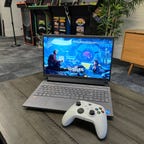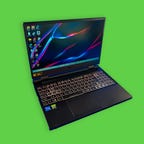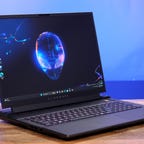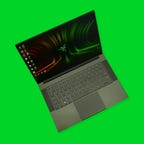 Why You Can Trust CNET
Why You Can Trust CNET Best Gaming Laptop for 2023
Check out our picks for the best gaming laptops from companies like Razer, Asus, Acer and more.
Gaming laptops are great for playing PC games on the go. They're also great if you'd rather have a (relatively) compact system than a desktop PC. But to choose the right one, you have to consider more than just a laptop's raw power and raw specs. And there are a lot of important nuances not reflected by a list of features.
A laptop with the best graphics card, solid-state drive and processor may have the specs to blow your mind, but it could all underperform if the components overheat easily -- or it throttles back performance to prevent that from happening. And though you probably don't always use an external mechanical keyboard with per-key RGB backlighting, a laptop's WASD keys can feel like mashed potatoes under your fingers.
Quality doesn't come cheap, but if you're on a tight budget and know where to compromise -- such as looking for a model with components you can upgrade later to make your upfront cost a little lower, or opting for a screen that's lower resolution and a slower refresh rate -- you can still get something that'll ensure a good gaming experience.
Plus, advances in cloud gaming mean you can play more games on lower-end hardware than ever before. So it's not a given that you'll need to bust your budget to pay for a new laptop. With cloud gaming, you do have subscription fees, so make sure to factor that in.
Check out our recommendations for best gaming laptops below. This list is periodically updated as we test and review products so you can find your own best gaming laptop.
Dell's G15 has been a favorite budget gaming laptop for the past few years, along with the HP Victus line. In late 2022, a 16-inch G16 joined the veteran 15-inch G15. If you're looking for a gaming laptop bargain, the G15 is the way to go. But if you can afford to spend a couple of hundred dollars more and don't mind the step up in size, the G16 is a better bet for longevity.
We do recommend waiting until the G15 goes on sale in order to buy a higher model, though, since the entry-level model incorporates only an RTX 3050. That may not future-proof you against the growing legion of power-hungry games.
The Acer Nitro 5 comes in both 17.3- and 15.6-inch sizes. A 17-inch cheap gaming laptop is a rarity with entry-level gaming laptops; most sub-$1,000 gaming laptops have 15.6-inch displays, and the Acer's larger screen lets you sink in and get lost in your chosen gaming world. The 17-inch version we reviewed starts at less than $900 with an AMD Ryzen 5 5600H,1080p screen and an GTX if you're OK with 8GB RAM. If you can manage about $200 more though, you can get a significantly better system, with an i7-11800H, RTX 3050 Ti and 16GB RAM.
At this level, you'll be able to play current games at FHD resolution with the graphics settings at medium to high, depending on the game you're playing. Still, Acer makes an affordable gaming laptop that packs in some nice extras like direct controls for power and cooling and upgrades access to memory and storage.
One of the first of the new generation of 18-inch laptops, the m18 can get expensive if you push it up to a high configuration -- an RTX 4090 and Core i9-13900HX will get you to $3,300 even without a lot of memory or storage. But if the big screen is most important to you, it starts at $2,000 with a respectable i7-13650HX and RTX 4050. And don't expect great battery life, and the fans can get loud when you're pushing it.
A smaller version than the 15-inch staple, the 14-inch Razer Blade delivers a lot of gaming power for its size without feeling small -- an important consideration for a gaming laptop. It also offers decent battery life, a nice size for travel and a subtle design (for a gaming laptop) that's buttoned-up enough for sitting in a meeting with the top brass or clients.
Thin, fast and Corsair'd up with Elgato streaming controls and wireless for Corsair accessories, the Voyager laptops are best in a class of their own. Corsair ships a few preconfigured models of its own, but the company's Origin PC subsidiary offers an Origin Pro Edition that you can configure with its custom UV printing as well as memory and storage capacity. Keep in mind that the Corsair utilities can sometimes confuse the hell out of you.
Asus pairs an ultraportable 13-inch two-in-one that has a relatively powerful AMD CPU with an optional external GPU dock equipped with a near-top-of-the-line Nvidia GeForce RTX 4090 mobile processor (though pricey at $4,260), and the result is an incredibly flexible system for both work and play that outperforms many bigger, clunkier gaming laptops. Because it's a two-in-one, you can comfortably use an external gaming keyboard without the built-in keyboard getting in the way. The stand-alone model has gotten an upgrade to an Nvidia RTX 3050 Ti since I reviewed it, but the bundle with the XG Mobile still has a GTX 1650.
Read our ROG Flow X13 with XG Mobile review.
If you want something bigger there's now a 16-inch model, the ROG Flow X16, with an AMD Ryzen 9 6900HS and RTX 3060 -- it also works with the XG Mobile, and starts at about $2,000.
Former favorites
Old picks never die, well, at least until you can't buy them anymore.
The HP Victus 16 is a strong, affordable option. It offers a respectable balance for people with different needs for play and work. Spending more will likely get you better build quality and more enjoyable audio. But if you can get past the screen wobble, the Victus can hold its own against pricier models.
Prices start at about $700 for the 15-inch model, but I really recommend avoiding configurations with 8GB RAM; MacOS can get away with that, but Windows has more overhead. For a little more ($890), you can get a reasonable low-end model that you won't outgrow quickly with an Intel i5-12450H, 12GB RAM, 512GB PCIe NVMe, a 144Hz 1080p screen and GeForce GTX 1650.
The cheapest model should still be able to play most games in 1080p with the graphics settings at medium to high.
Other notable gaming laptops we've tested
We're working our way through a raft of 2023 systems, and we'll update here with those that stand out -- just not quite enough for a blanket recommendation.
Razer Blade 18(starts at $3,000): It has Razer's iconic slim Blade design and it's big and fast, which makes it ideal for a power laptop for work as well as gaming, but it's not the fastest we've tested and it's quite expensive. Read our Razer Blade 18 review.
Gaming laptop FAQs
Do you still have to compromise on battery life?
Gaming laptops have traditionally had to compromise on battery life, which typically lasted as little as two hours of nonstop gaming. You also couldn't play most complex games -- GPU- or CPU-intensive ones -- on battery power. Processors would get throttled back and screens dim during hard-core gaming sessions, so a laptop that felt nimble when connected became a slog on battery power, turning your epic battles into battles of frustration.
That's been changing recently, as Intel, AMD and Nvidia have concentrated on improving their power management technologies. No, you still can't play for 10 hours on battery power, but now you can find some great gaming laptops with 10-hour battery lives -- albeit not for playing -- to make gaming on the road more feasible.
The Asus ROG Flow X13 and the optional Mobile XG: A small, lightweight laptop with a powerful AMD Ryzen 5900HS CPU and an Nvidia GTX 1650 GPU for lightweight gaming. The external dock incorporates an RTX 3080 mobile GPU and extra connections.
What do I need to know about a gaming laptop's GPU (beyond speed)?
The fastest graphics processor currently available in a laptop is the Nvidia Geforce RTX 4090, with the usual Max-Q variants. The Max-Q versions run at slower frequencies than their full-size siblings -- that keeps down the noise and heat and allows them to fit into thinner designs. RTX models also accelerate ray-traced rendering and provide intelligent upscaling (also known as DLSS) where it's explicitly supported. If your favorite games don't use it, the lower-end Nvidia GTX 1660 Ti incorporates Turing, the last generation of Nvidia's technology, without the extra cost or power burden of the RT cores.
We're finally seeing a lot more system implement Nvidia's Advanced Optimus version of Max-Q, which is great. It's smarter, with integrated and discrete graphics sharing (rather than switching) the same pipeline to the display, no reboot necessary.
The older version of Optimus, that's still used by a lot of laptops, requires you to reboot in order to switch between a high-power-draw dedicated GPU mode and a power-saving mode; the latter only uses the GPU for accelerating, not actually drawing the screen (so every frame has to travel from the GPU's dedicated memory over the system bus to the CPU and then to the screen rather than going directly from the GPU memory to the screen). That means it can't take advantage of adaptive refresh-rate technologies and it can negatively affect frame rates.
We haven't yet tested models with AMD's current high-power laptop GPUs, the RX 7600M, RX 7600M XT, RX 7700S and RX 7600S, but based on the performance of desktop 7000 series models I don't expect them to hit the highs of Nvidia's best, but they tend to be solid midrange performers. The "S" versions are the lower-power models designed to fit better in the thinnest laptops.
Intel launched its first generation of Arc discrete high-performance GPUs a while back, but we've yet to see any for gaming laptops.
Does a gaming laptop's CPU matter?
Yes, but not always. In general, sims benefit from faster clock speeds and more cores since those are required for the heavy calculations when worlds get complex. More and more AAA games are also starting to balance loads better between the CPU and GPU where possible as well. And if you bounce back and forth between a game and the rest of Windows, it can help speed that kind of multitasking a bit.
Still, a lot of games, especially first-person shooters, still don't take advantage of more than four cores. Intel jumped to 10nm Alder Lake for its 12th-gen CPUs, which combined performance and power-efficient cores similar to Apple's M1 and M2 chips, and made a huge difference in battery life, as well as to system performance on battery, that has trickled down to gaming laptops.
What do I need to know about screen size and refresh rate?
There's lots to know if you're choosing a new gaming screen. All the major companies bumped their flagship 1080p configurations to 360Hz, but for many a gamer, they're not essential: 240Hz max should be fine for those few times you can get frame rates above 240fps. Even 144Hz will do for many people. But artifacts like tearing, caused by the screen refresh rate becoming out of sync with the frame rate, depend on your games as much as your laptop brand and hardware.
We're also seeing a lot more 120Hz 4K screens in the flagship models in all sizes and a ton of 165Hz and 240Hz QHD (1440p) options. The latter are my favorites, balancing higher resolution -- certainly enough on a laptop screen -- with gaming-friendly refresh rates.
How we test computers
The review process for laptops, desktops, tablets and other computer-like devices consists of two parts: performance testing under controlled conditions in the CNET Labs and extensive hands-on use by our expert reviewers. This includes evaluating a device's aesthetics, ergonomics and features. A final review verdict is a combination of both those objective and subjective judgments.
The list of benchmarking software we use changes over time as the devices we test evolve. The most important core tests we're currently running on every compatible computer include: Primate Labs Geekbench 5, Cinebench R23, PCMark 10 and 3DMark Fire Strike Ultra.
A more detailed description of each benchmark and how we use it can be found in our How We Test Computers page.
More for gamers
- Best Graphic Card for Gamers and Creatives for 2023
- Fastest VPNs for 2023
- Best VPN Service for 2023
- Best Budget Laptop 2023: Our Top 6 Picks Starting at $300
- Best 15-inch Laptops for 2023
- 3 Great VPNs for Xbox for 2023
- Best Mouse for 2023
- 5 Monitors Worth Checking Out for 2023
- Best TVs for Gaming With Low Input Lag
- Razer Blade Pro vs. Origin PC Evo16-S
- Best Laptop Backpack for 2023
- Best Gaming PC for 2023
- Best TVs for PS5 and Xbox Series X, Series S with 4K, 120fps Input and VRR
- Best DSL Internet Providers of 2023
- Best Rural Internet Providers of 2023
- Best Desktop Computers for 2023






